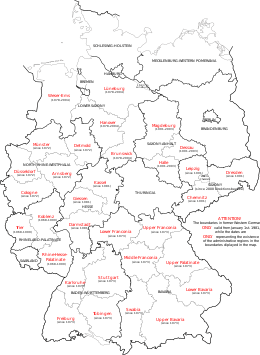
Regierungsbezirke as from 1 August 2008. In the map there are also shown the former RBs of Lower Saxony, Rhineland-Palatinate and Saxony-Anhalt and Saxony
 |
| This article is part of the series: Politics and government of Germany |
|
Constitution ("Basic Law")
|
|
Executive
|
|
Legislature
|
|
Judiciary
|
|
Administrative divisions
|
|
Elections
|
| Foreign relations |
|
Regierungsbezirk (pronounced [ʁeˈɡiːʁʊŋsbəˈt͡sɪʁk], abbreviated Reg.-Bez.) is an administrative region on federal state level in Germany. The regional authority is called Regierungspräsidium or Bezirksregierung (District Government) and headed by a Regierungspräsident (District President).
The Regierungsbezirke do not pass any legislation. Within the federal state authority, they act as a mid-level agency mostly concerned with administrative decisions on a regional level for the affiliated districts.[1]
Translations[]
History[]
The first Regierungsbezirke were established in the course of the Prussian reforms between 1808 and 1816, when the Kingdom of Prussia divided its provinces into 25 Regierungsbezirke. Upon the German unification of 1871, the concept was adopted by several States of the German Empire.
The Regierungsbezirke of North Rhine-Westphalia are in direct continuation of those created in the Prussian Rhine and Westphalia provinces in 1816. Other states created similar entities, named Kreishauptmannschaft (in Saxony) or Kreis (in Bavaria and Württemberg) (not to be confused with the present-day Kreis or Landkreis districts). In Nazi Germany the naming was unified to Regierungsbezirk.
Regierungsbezirke by state[]
Currently, only four large area states out of 16 in total are divided into Regierungsbezirke, all others are directly divided into districts without mid-level agencies. Those four states are divided into a total of 19 Regierungsbezirke, ranging in population from 5,255,000 (Düsseldorf) to 1,065,000 (Gießen):
- Baden-Württemberg: Freiburg, Karlsruhe, Stuttgart, Tübingen
- Bavaria: Upper Bavaria, Lower Bavaria, Upper Palatinate, Upper Franconia, Middle Franconia, Lower Franconia, Swabia
- Hesse: Darmstadt, Gießen, Kassel
- North Rhine-Westphalia: Arnsberg, Cologne, Detmold, Düsseldorf, Münster
On 1 January 2000 Rhineland-Palatinate disbanded its three Regierungsbezirke Koblenz, Rheinhessen-Pfalz and Trier – the employees and assets of the three Bezirksregierungen were converted into three public authorities responsible for the whole state, each covering a part of the former responsibilities of the Bezirksregierung.
On 1 January 2004, Saxony-Anhalt disbanded its three Regierungsbezirke: Dessau, Halle and Magdeburg. The responsibilities are now covered by a Landesverwaltungsamt with three offices at the former seats of the Bezirksregierungen.
At the foundation of Lower Saxony in 1946 by the merger of the three former Free States of Brunswick, Oldenburg, Schaumburg-Lippe and the former Prussian province of Hanover the former two states became Verwaltungsbezirke (roughly administrative regions of extended competence) within Lower Saxony besides the less autonomous Prussian-style Regierungsbezirke comprising the former Province of Hanover and the tiny Schaumburg-Lippe. These differences were levelled on 1 January 1978, when four territorially redeployed Regierungsbezirke replaced the two Verwaltungsbezirke and the old six Regierungsbezirke: Brunswick and Oldenburg as well as Aurich, Hanover (remaining mostly the same), Hildesheim, Lüneburg (old), Osnabrück and Stade. On 1 January 2005, Lower Saxony disbanded its remaining four Regierungsbezirke: Brunswick, Hanover, Lüneburg, and Weser-Ems.
On 1 August 2008, Saxony restructured its districts (Landkreise) and changed the name of its Regierungsbezirke to Direktionsbezirke. This was necessary because one of the new districts did not fit with the borders of the old Regierungsbezirke and some responsibilities are now covered by the districts. The Direktionsbezirke are still named Chemnitz, Dresden and Leipzig. As of 1 March 2012, the Direktionsbezirke were merged into one Landesdirektion.
Three of the new federal states re-established in 1990, Brandenburg, Mecklenburg-Vorpommern and Thuringia, decided not to implement Regierungsbezirke. In Schleswig-Holstein and Saarland they never existed.
Historic Regierungsbezirke[]
- Prussia
- Berlin, comprising the city and several suburbs, incorporated into Regierungsbezirk Potsdam of Brandenburg in 1822
- Kleve, Province of Jülich-Cleves-Berg, incorporated into Düsseldorf region in 1822
- Reichenbach, Province of Silesia, incorporated into Breslau and Liegnitz regions in 1820
- Stralsund, Province of Pomerania, incorporated into Stettin region in 1932
- Dissolved in 1919/20 after cession of territory according to the Treaty of Versailles:
- Bromberg, Province of Posen
- Danzig, Province of West Prussia (see Free City of Danzig)
- Lorraine, Imperial Land of Alsace-Lorraine
- Lower Alsace, Imperial Land of Alsace-Lorraine
- Marienwerder, Province of West Prussia, re-established as West Prussia region of the East Prussia province in 1922
- Posen, Province of Posen
- Upper Alsace, Imperial Land of Alsace-Lorraine
- Established after the 1939 Invasion of Poland, dissolved in 1945:
- Hohensalza, Reichsgau Wartheland
- Katowice, Province of Silesia (Upper Silesia from 1941)
- Litzmannstadt (Kalisch until 1941), Reichsgau Wartheland
- Posen, Reichsgau Wartheland
- Zichenau, Province of East Prussia
- Former eastern territories, dissolved in 1945:
- Allenstein, Province of East Prussia
- Breslau, Province of Silesia
- Gumbinnen, Province of East Prussia
- Köslin, Province of Pomerania
- Königsberg, Province of East Prussia
- Liegnitz, Province of Silesia
- Oppeln, Province of Silesia
- Posen-West Prussia (Schneidemühl), Province of Pomerania, established in 1938
- Stettin, Province of Pomerania
- Allied-occupied Germany:
- Minden, Province of Westphalia, incorporated into Detmold in 1947
- Sigmaringen, Province of Hohenzollern, incorporated into Württemberg-Hohenzollern in 1946.
References[]
- ^ Regional Governments in France, Germany, Poland and The Netherlands (HTML version of PowerPoint presentation) – Cachet, A (coordinator), Erasmus University, Rotterdam
- ^ http://www.regierung.oberbayern.bayern.de/englisch/
- ^ http://www.regierung.oberfranken.bayern.de/en/index.php
- ^ http://www.regierung.unterfranken.bayern.de/service/englisch/00101/index.html
External links[]
Media related to Regierungsbezirk at Wikimedia Commons
| ||||||||
Template:Terms for types of country subdivisions
| This page uses content from the English language Wikipedia. The original content was at Regierungsbezirk. The list of authors can be seen in the page history. As with this Familypedia wiki, the content of Wikipedia is available under the Creative Commons License. |